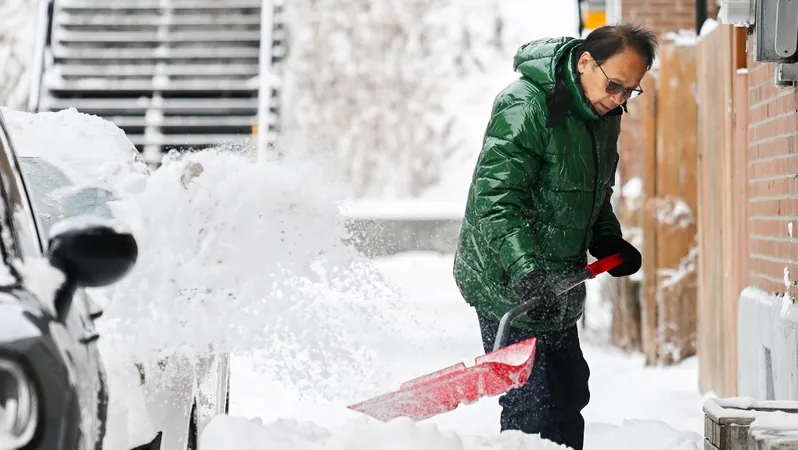
Essential Steps to Safeguard Yourself from Winter Weather Hazards
2025-01-05
Author: Michael
Essential Steps to Safeguard Yourself from Winter Weather Hazards
As winter settles in, the risk of various hazards increases, posing significant threats to your safety and well-being. From the dangers of carbon monoxide poisoning to the threats of hypothermia and the potential for frozen pipes, it’s crucial to be proactive in safeguarding yourself and your home during this chilly season.
Be Prepared for the Cold Blast
With millions across the United States facing moderate to heavy snow and frigid temperatures this week—stretching from Kansas City to Washington—it's vital to assess your winter preparedness. Public safety officials emphasize the importance of taking proactive steps to stay warm and secure during winter storms.
Staying Safe Indoors
When winter storms strike, staying indoors is the safest option. However, prolonged use of heating systems increases the risk of carbon monoxide (CO) poisoning, a silent threat that can stem from furnaces, stoves, and generators. Since carbon monoxide is odorless and colorless, it’s crucial to remain vigilant. The Centers for Disease Control and Prevention (CDC) warns that symptoms, which may start with mild headaches or nausea, could escalate quickly to severe consequences, including loss of consciousness.
Dr. Alex Harding, assistant professor of emergency medicine at Baylor College of Medicine, stresses the insidious nature of carbon monoxide symptoms. "It creeps up on individuals, and they may not realize they’re in danger until it’s too late,” he cautions.
To mitigate this risk, ensure your home is equipped with functioning carbon monoxide detectors, and never run a gas-powered generator indoors or in attached garages.
Avoid Hypothermia Risks
The current cold snap, especially affecting the East Coast, presents heightened risks for hypothermia, which occurs when the body loses heat faster than it can generate it. Jon Palmer, a meteorologist for the National Weather Service, warns that icy temperatures can unexpectedly impact regions that have been relatively mild. Wind chill factors can lead to dangerously low temperatures, exposing individuals to frostbite and hypothermia in a matter of minutes.
If conditions worsen, Harding notes the critical importance of finding shelter. "The elderly, homeless, and those with disabilities are especially vulnerable,” he points out, emphasizing the need for safe, warm places with essential supplies like food and water.
Protecting Your Home from Pipe Damage
Frozen pipes can wreak havoc on your home, particularly in southern regions where plumbing might not be insulated for extreme cold. To prevent costly repairs, master plumber Jose Parra recommends several preventive measures: insulating exposed pipes, draining sprinkler systems, and allowing indoor faucet to drip to keep water flowing and prevent freezing. Procrastination can lead to extensive damage and costly repairs, with Parra noting that up to 90 percent of plumbing issues could be prevented through proper preparation.
Electric Vehicle Care in Cold Weather
If you own an electric vehicle, be aware that cold temperatures can impact battery performance. Lithium ions move sluggishly in colder conditions, which can limit battery range and deplete power rapidly. However, with careful planning—such as keeping your car warmer and charging it in a heated space—you can mitigate some of these effects. Automotive engineers are continually developing new battery technologies that can withstand colder climates, promising better performance for electric vehicles as winter conditions evolve.
As winter unfolds, we must prioritize safety and preparation to navigate the risks associated with cold weather. By taking these precautions, you can protect yourself and ensure your home remains a warm sanctuary during the harsh winter months. Stay warm, stay safe, and be ready for whatever winter throws your way!



 Brasil (PT)
Brasil (PT)
 Canada (EN)
Canada (EN)
 Chile (ES)
Chile (ES)
 Česko (CS)
Česko (CS)
 대한민국 (KO)
대한민국 (KO)
 España (ES)
España (ES)
 France (FR)
France (FR)
 Hong Kong (EN)
Hong Kong (EN)
 Italia (IT)
Italia (IT)
 日本 (JA)
日本 (JA)
 Magyarország (HU)
Magyarország (HU)
 Norge (NO)
Norge (NO)
 Polska (PL)
Polska (PL)
 Schweiz (DE)
Schweiz (DE)
 Singapore (EN)
Singapore (EN)
 Sverige (SV)
Sverige (SV)
 Suomi (FI)
Suomi (FI)
 Türkiye (TR)
Türkiye (TR)
 الإمارات العربية المتحدة (AR)
الإمارات العربية المتحدة (AR)